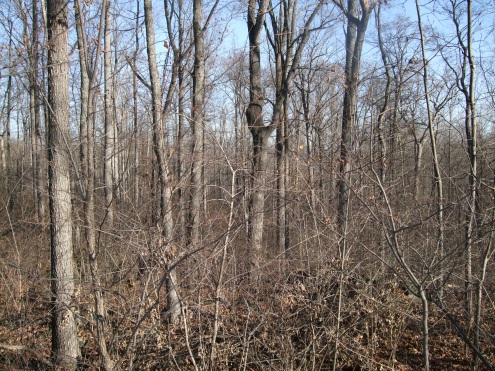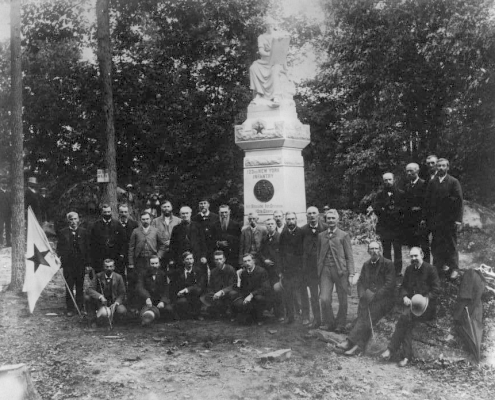
Survivors of the 123 NY Volunteers at the dedication of their monument at Gettysburg, PA on September 4, 1888. (25 years after the battle of Gettysburg.)
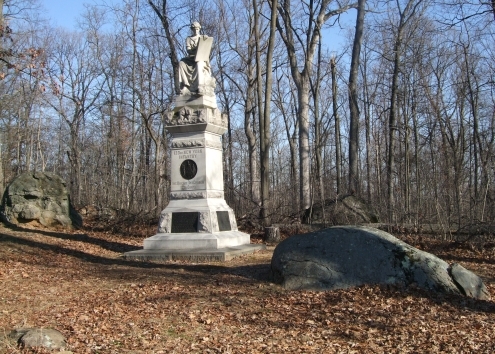
The monument as it looks today. The 123rd was comprised of volunteers from Washington County, NY including the towns of Dresden and Whitehall. (The 150th anniversary of the battle of Gettysburg will be July 1-3, 2013.)
(Top two pictures only – click to see full scale.)
Face plate of the monument reads:
123rd. New York
Infantry
1st. Brigade 1st. Division
12th. Corps
Imagine a young man from Washington County, NY in August of 1862 who volunteers to serve in the Union army. He gets sent to Washington DC, where he is assigned to the Army of the Potomac and winds up marching to Gettysburg in July 1863, where he will not only take part in the battle which arguably turns the course of the war but his regiment defends an important part of the Union line.
Well, that’s exactly what happened to Washington County’s 123rd brigade. Mustered into the Union army in September 1862, they joined the Army of the Potomac and were engaged in the battles of Chancellorsville and Gettysburg before being transferred to the Army of the Cumberland where they participated in the Campaign of Atlanta, the March to the Sea, and the Campaign of the Carolinas. The survivors were mustered out of Washington, DC, at the close of the war, on June 8, 1865 and returned to Washington County, NY.
Last week, I traveled to Gettysburg, located the monument to the 123rd, and learned about the heroics shown by our local citizen-soldiers there in 1863. The story which follows should be known by all residents of Washington County.
To begin, the battle of Gettysburg was a series of bloody skirmishes that took place during three days: July 1-3, 1863. The Confederate army was at it’s peak and had marched up through Virginia into Pennsylvania. Confederate General, Robert E. Lee, wanted to attack Washington DC from the north and hoped to conclude the war if successful. He had approximately 94,000 men with him. The Union army was in a defensive fishhook-like position defending the high ground on a number of hills south and west of Gettysburg. Union General, George Meade, commanded approximately 75,000 men.
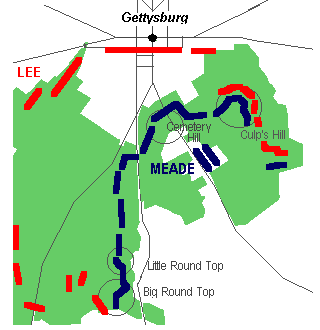
A map of the Gettysburg battlefield. Union forces (in blue) were shaped in a fishhook-like position defending the high ground south of the town of Gettysburg. Confederate forces (in red) attacked over a three day period from the north. Culp’s Hill was important because it was the right flank of the Union line.
The 123rd marched north to Gettysburg from Littlestown, PA on July 1, 1863. The next day, they advanced up Culp’s Hill and formed the right flank of Union lines. They constructed a heavy breastwork barricade of logs. At about 6 p.m. on July 2, 1863 they moved to support the left flank of Union lines near Little Round Top. Returning in the night they found the works they had constructed earlier in the day in possession of the Confederacy as no troops had been left to occupy them.
The 123rd engaged in the most ferocious fighting on July 3rd. During the morning, under cover from artillery from Connecticut’s 20th, they made a charge up Culp’s Hill and recovered the works they had constructed the previous day. They then proceeded to fend off two assaults by Confederate troops who wanted to retake the Culp’s Hill position and breach the right flank of the Union line.
NY’s 123rd saw close fighting on July 3rd at the battle of Gettysburg. Confederate forces came up Culp’s Hill through the woods after the 123rd had retaken this position. This is the view the Washington County soldiers would have had of advancing Confederate troops.
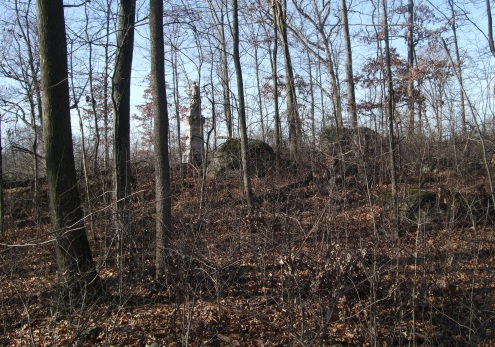
After recapturing the high ground, Washington County forces fought from a position of strength from barricades they had constructed the previous day. This is the view the Confederate soldiers would have had of the dug-in 123rd. Log fortifications, hastily constructed the day before, and boulders were used as protection by the 123rd. (This area is directly behind where the monument is now located.)
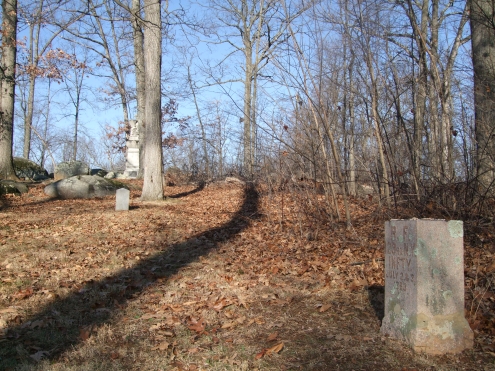
The marker in the bottom right corner shows the right-flank of the 123rd’s line on Culp’s Hill.
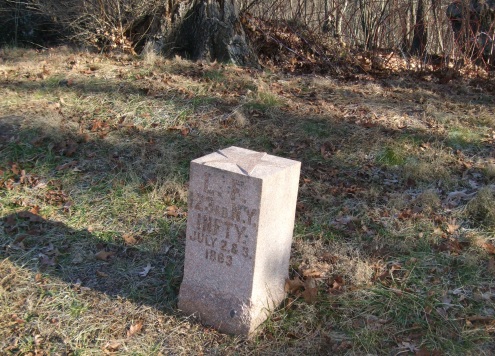
The stone marker shows the left-flank of the 123rd’s line on Culp’s Hill.
Once the southerners retreated from Culp’s Hill around mid-day, the 123rd was ordered to support the Union front line repelling Pickett’s charge at about 4 pm. This famous frontal assault by the Confederate’s would end in defeat and prove devastating to the South at Gettysburg. Later in the evening of July 3rd, after the 123rd had returned to Culp’s Hill, there were more skirmishes with the southerners, where heavy causalities were taken by the Confederates.
Lee retreated with the remnants of the Confederate army into Virginia. General Meade breathed a sign of relief, knowing that the Union troops had repelled the South and defended Washington, DC.
The 123rd left Gettysburg on July 4, 1863. In total, during the three days of fighting, they lost 14 soldiers.
Today, there is an observation tower on Culp’s Hill where much of the Gettysburg battlefield can be seen.
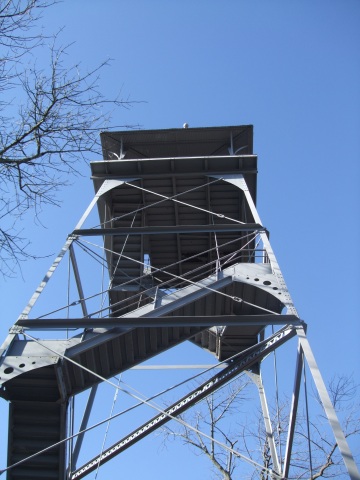
The Culp’s Hill observation tower today.
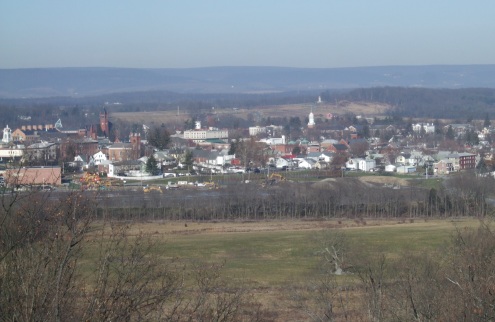
A view of Gettysburg, from the Culp’s Hill observation tower. Pickett’s charge took place below.
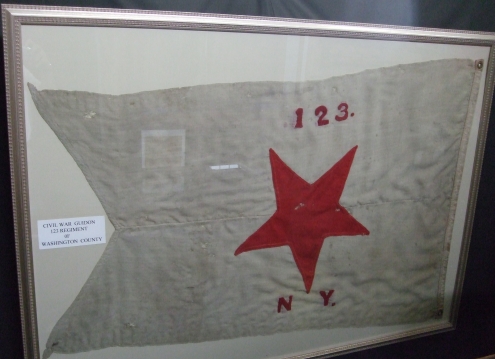
The 123rd’s flag, hangs in the Skenesborough Museum in Whitehall.

